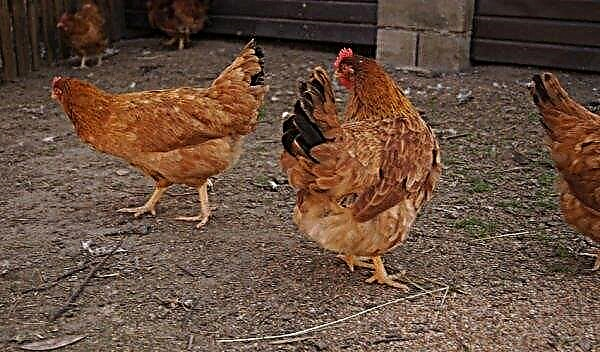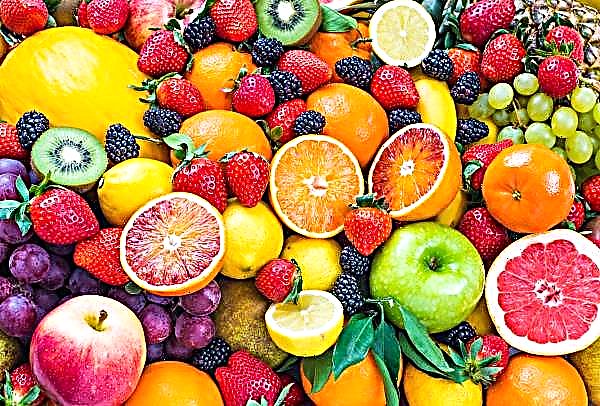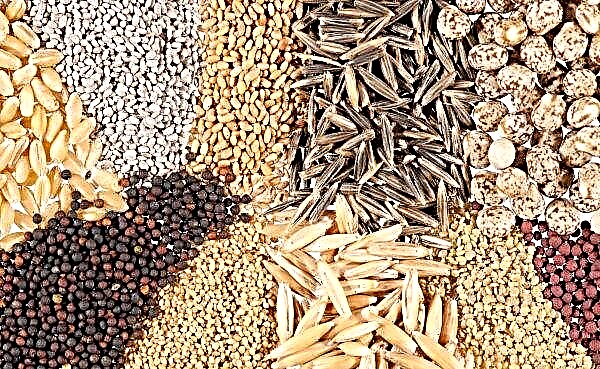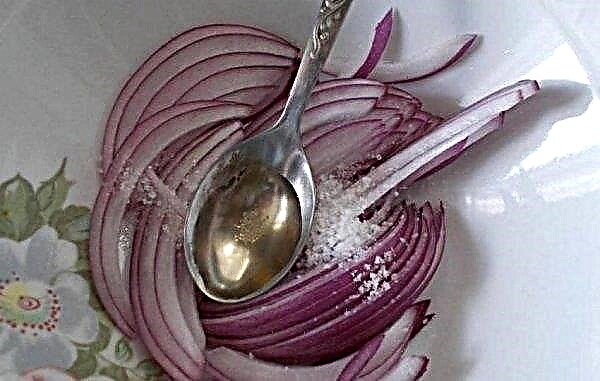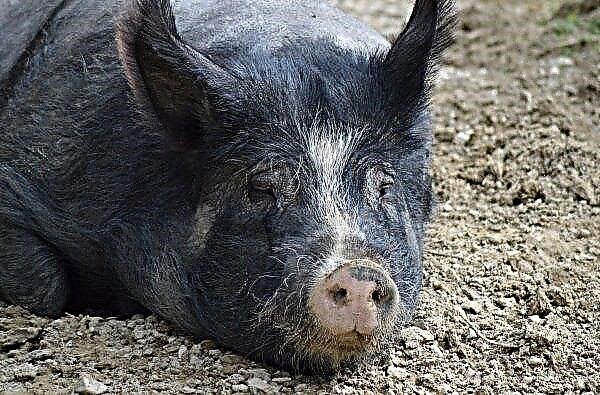Ask any person a question about the shape of a watermelon, and everyone will answer without exception that it is round or elongated-oval. And they will be right! Nevertheless, there is such an exotic thing as cubic watermelon. The article will discuss methods for growing sweet berries in the form of a large cube.
Did you know? One of the first copies of black watermelon of the Japanese variety Densuke, the most expensive of all, was bought at auction for more than $ 6,000.
The origin of square watermelons
Cubic-shaped watermelons appeared in Japan more than 20 years ago, when in the city of Tsentsuyu, farmers began to lay the ovaries of ordinary round berries in containers in the form of a cube. As the fruits of the gourds grew, they took the form of a cube. The only difference between this fruit and the "classic" is its price to the consumer. The average cost of a square berry is around 80 US dollars.
Advantages and disadvantages of square watermelons
- The advantages can be considered as follows:
- Transport and warehouse logistics are simplified because, having the correct cubic shape, such fruits are convenient to store and transport.
- It is convenient to place in household refrigerators and when laying the table.
- Due to their stability, such fruits are cut more accurately.
- Negative points:
- The painstaking process of growing. Daily monitoring of fruit development is required so that the appearance and form do not lose their trade attractiveness.
- In less experienced gardeners, gourds ripen unevenly or do not have time to reach technical ripeness.
- The high cost of the final product for the consumer.
The best varieties of square watermelons
Since the berry of an unusual shape is not the result of breeding work or genetic engineering, the formation of the fetus comes from the seeds of ordinary, rounded watermelons. At the same time, some varieties for open ground with a shortened ripening period (hybrids with a short growing season) are distinguished, which can be used to obtain outlandish forms.
These include:
How to grow at home
Let's move on to the description of agricultural techniques for growing “square” berries.
The basic rules for growing square watermelons
What the container looks like for the formation of a cubic fruit - the answer is simple: the cube shape is rigid in structure (20x20x20 cm), where the watermelon ovary is placed, made of transparent or black glass or plastic, a folding reusable design, with a lid and a hole for the stem. In the process of ripening and growth, the berry takes on the form of a box in which it is formed.
Did you know? In the 50s of the last century, in Japan, a seedless variety of watermelon was bred by selection method, which today is very popular all over the world.
Making a box for a square watermelon
We proceed directly to the manufacture of containers for the formation of a given shape of the fetus.
Necessary materials and tools
The necessary set of tools and materials that will be needed to create a container:
- sheets of transparent or black glass, polycarbonate, plastic. Material thickness - 0.5–0.8 cm;
- nuts, screws, screws;
- furniture hinges;
- cutting and sawing tools;
- screwdriver, drill, ruler, marker.

Box manufacturing process
The algorithm how to make the box:
- square sheets with a side of 20 cm are cut from sheet material;
- in one of the obtained squares saw a hole for the stem of the plant;
- a cubic structure is formed from the cut-out square blanks using fastening fittings;
- the square, which will be a hinged lid, is fixed on one side to furniture hinges.
Important! The growing berry needs constant ventilation, so small holes must be made in the form (in the corners).
Growing conditions
You can achieve a positive result in regions with a southern, stable, warm climate. Watermelon is not picky regarding soil fertility, however, it should be “light” and loose, mainly sandy. A bed with growing plants requires as long as possible lighting during the day.
Landing Features
Watermelons are planted in the ground in two ways: seedlings and seeds.
Seedling method
This method of growing gourds is suitable for regions with a relatively short thermal period to reduce the risks of not ripening fruits:
- In the early days of May, watermelon seeds are sown in individual glasses with a volume of at least 300 ml to prevent subsequent picking. The soil is prepared from sand, peat and sod soil in equal parts with the addition of a complex of mineral fertilizers.
- Seeds for half an hour are placed in hot water (approximately + 50 ° C) and germinated in constantly moistened sand until a small root appears, after which they are transferred to individual glasses, a layer of sand is poured on top and covered with a plastic wrap. The temperature in the room where the seedlings are located should not fall below + 25 ° C during the day and + 20 ° C at night.
- Lighting should be present at least 12 hours a day, otherwise the plants will begin to thin and stretch. If necessary, it should be illuminated with a phyto lamp or other light sources.
- When three leaves are formed, top-dress with a weak solution of organic fertilizer and complex mineral.
- In June, plants are transferred to a permanent place in open ground, maintaining a distance between plants of one meter, or in a greenhouse (the distance between plants should be at least 70 cm).

Seed directly into the ground
Watermelon seeds are sown on the beds in mid-May. In each hole, which are staggered relative to each other at a distance of 0.3 m, put a few seeds. After germination, the most viable plant is left. Along the ridge, additional free space should be provided for lashes that do not touch or move in order to avoid damage to the ovaries.
How to care for watermelons
After the final formation of the ovary occurs and it reaches the size of an apple, it is necessary to carefully place it vertically in a box, while the stem is brought out. With strong sunshine, the boxes are covered with "breathing" material.
Important! In order to avoid excessive accumulation of fertilizers in the soil, alternate components during top dressing and make them extremely metered.
Watering
With a lack of moisture, a watermelon is not able to form juicy, large berries. Despite the fact that the plant has a powerful branched root system, it needs to be watered throughout the growing season. Young seedlings are watered daily. After the appearance of flowers and an increase in green mass, water is applied as the upper soil layer dries, but at least once a week. About a month before the harvest, watering is recommended to be completely stopped so that the sugar content in the fruits becomes maximum. Watering is carried out "under the root." Ice water cannot be used - from a well or a well.
About a month before the harvest, watering is recommended to be completely stopped so that the sugar content in the fruits becomes maximum. Watering is carried out "under the root." Ice water cannot be used - from a well or a well.
Top dressing
When growing gourds, you need to know if there are special recommendations when applying fertilizers. Farmers advise to fertilize watermelons three times for the entire growth period in the ridges or in the greenhouse:
- The first fertilizer application is carried out a week after planting seeds or transplanting seedlings.
- Secondary feeding is made two weeks after the first.
- The third time - 12 days after secondary feeding.
Organic fertilizers are mainly used as “nutrition” - chicken droppings, humus. Of inorganics, it is advised to use ammonium nitrate, diammofoska.
Pest and Disease Control
Watermelons are subject to diseases such as Ascochitosis, peronosporosis, powdery mildew, anthracnose. For the purpose of prevention and treatment, according to the instructions, Abiga-Peak, Ordan, HOM, colloidal sulfur are used. Sprout fly, moth, dustpan, aphid can cause serious damage to bahce. As a prophylaxis, it is recommended to treat plants with biological products (for example, Fitoverm). If there are many pests, they use insecticides - "Decis", "Tantrek", "Fufanon".
Features of the collection and storage of square watermelons
A cube-shaped crop should be collected on the basis of the same signs of ripeness as in “ordinary” watermelons — a dry stalk, a white or yellow spot at the point of contact with the contact surface, and fading of the crust. Ripe, undamaged fruits are left for storage, placing them in equal rows on a smooth surface, previously covered with straw.
Having made a thick-walled cubic shape and timely placing a small berry inside it, you can grow an unusual-shaped watermelon. And with careful care and compliance with all the rules of agricultural technology, the “square” representative of melons will become a juicy and fragrant dessert, striking everyone with an unusual appearance.

